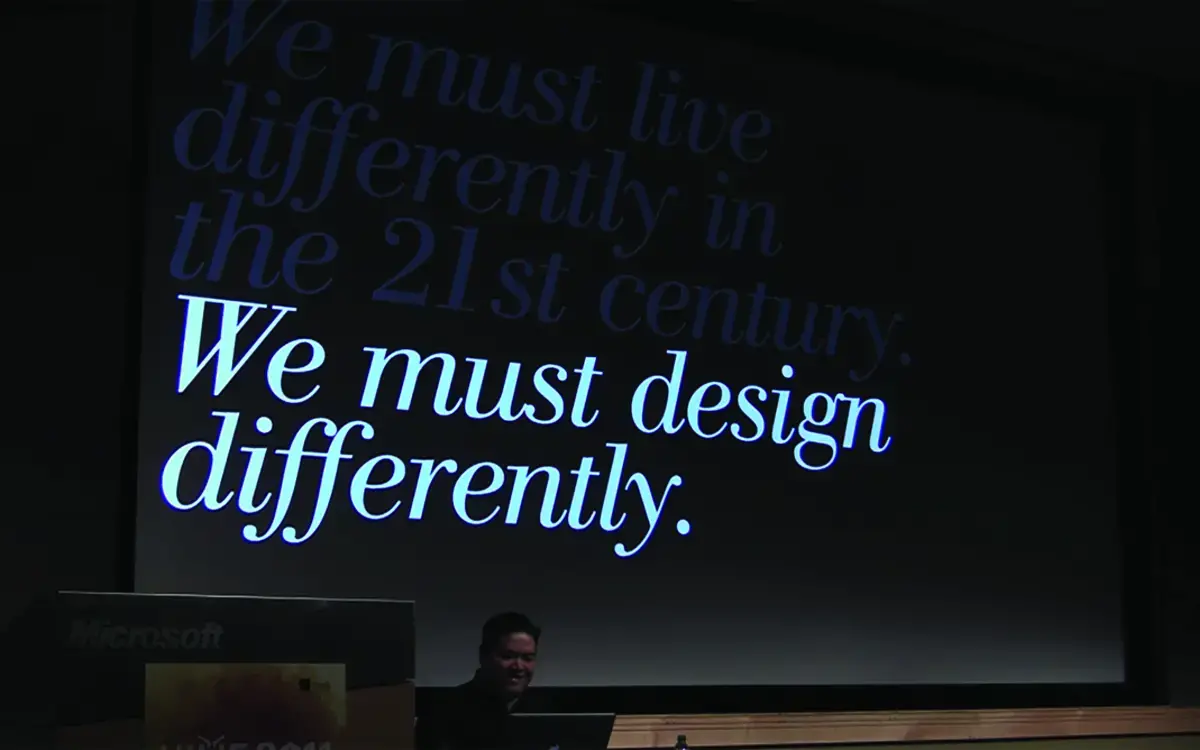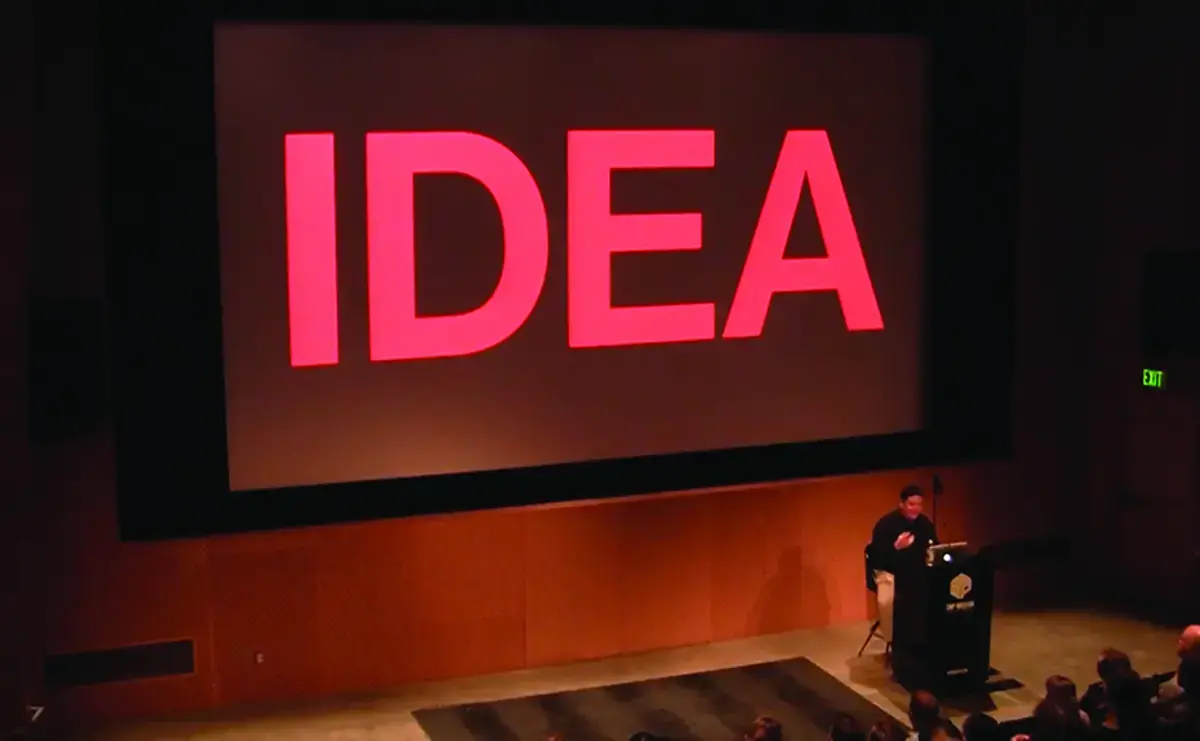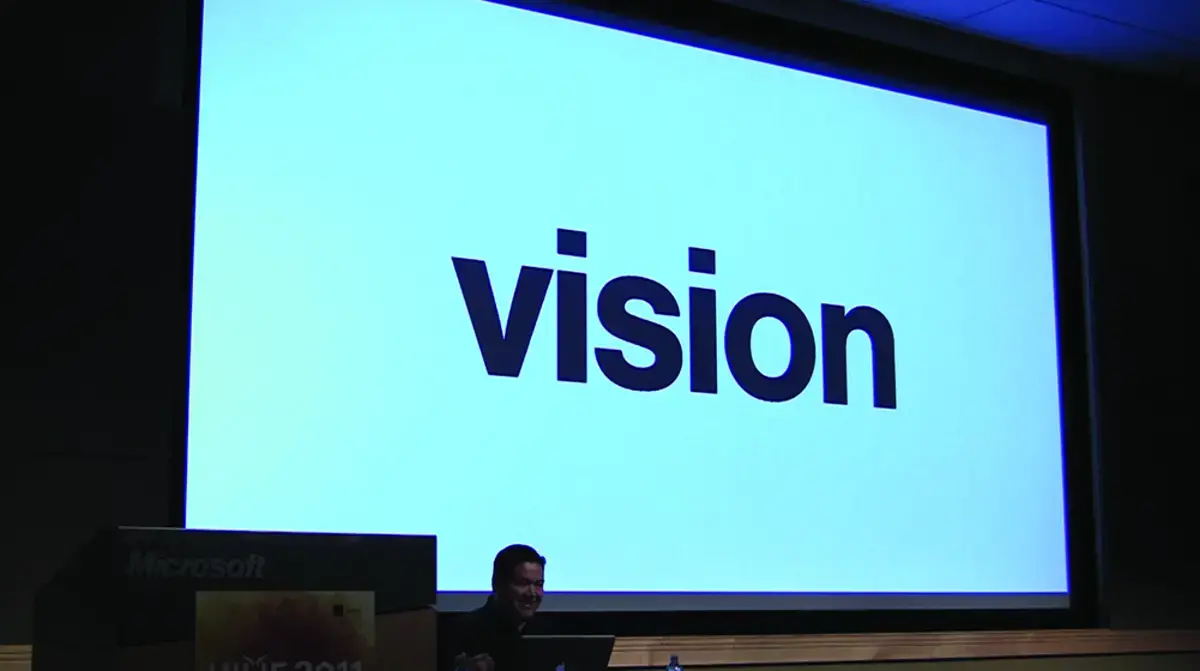Every Crisis Is a Crucible

After an accident left him paralyzed at 42, August de los Reyes ’95, head of research and design at Pinterest, gained a valuable perspective that would reorient the focus of his work and challenge the paradigms of 21st-century design. By Brian Davidson
On April 12, 2013, in a small theater in Seattle, August de los Reyes ’95, then lead designer for Xbox at Microsoft, was presenting a lecture on “The Future of the Future of Design” as part of an ongoing speaker series for the local creative community.
He began the talk, which can still be found on YouTube, by examining the origins of his own obsession with the future, tracing it back to an early childhood fear of the unknown. He recalled, at age eight, watching The Man Who Saw Tomorrow, a documentary on the 16th-century visionary Nostradamus, and his ominous predictions for the future. The film left him “terrified, depressed, and engulfed in helplessness,” he said. How could he prepare for these catastrophes to come?
“I would argue that I was transformed,” de los Reyes said. “Now that I’m thinking back on it, this was one of the milestones in my life.”
From that point forward, de los Reyes was captivated by anything related to the nature of time. Is time a function of order or chaos? If the former, is the order linear or cyclical? If the latter, what can prior cycles tell us about the future?
Moving through his lecture, de los Reyes referenced what’s known as the Strauss-Howe Generational Theory, which posits that Anglo-American history repeats itself every 80–100 years through four distinct periods: the high time, the awakening, the unraveling, and the crisis. Currently, we are experiencing the unraveling; the crisis lies ahead.
But de los Reyes no longer felt terrified, depressed, or helpless, he told the audience. His early obsession with the future had pushed him toward the field of design, which not only plays a role in shaping the future, but also gives us the tools to adapt to it as it unfolds.
“Every crisis is a crucible,” he said, the words projected on a screen behind him.
He could never have predicted, 47 days later, how profoundly those words would resonate in his life.

Growing up in Shreveport, Louisiana, where his father, a doctor, held a faculty position at Louisiana State University Medical Center, de los Reyes found himself fascinated by the subject of mythology. In school, he studied Greek mythology, Hindu mythology, the Ryukyuan religion, and took a particular interest in the hammer-wielding, raven-flanked gods of Norse paganism.
He decided to pursue the subject in college, enrolling in the University of Minnesota’s Scandinavian Studies program—one of four such programs in the country. By the end of his second year, however, it became apparent that the program’s career track pointed straight back to academia.
At around this time, de los Reyes was reading Donna Tartt ’85’s recently published debut, The Secret History, which is set at Hampden College, a fictional facsimile of Bennington, where de los Reyes had previously considered applying. He connected to one passage in particular, in which Tartt’s narrator, Richard Papen, recalls coming across an old admissions brochure he received from Hampden before ultimately deciding to apply.
Even now I remember those pictures, like pictures in a storybook one loved as a child. Radiant meadows, mountains vaporous in the trembling distance; leaves ankle-deep on a gusty autumn road; bonfires and fog in the valleys; cellos, dark windowpanes, snow.
“I knew exactly what [Tartt] was talking about,” de los Reyes said. “For me, it was that famous late 80s admissions brochure. From a graphic design standpoint, it was just a beautiful print piece—it was back when the Bennington mark was in this sort of condensed Bodoni type—and I thought ‘wow, what a fascinating school.’”
Intrigued by Bennington’s progressive approach to learning, he transferred in 1994, the same year the College was chosen as one of 22 academic institutions to participate in the newly formed New Media Consortium. A joint initiative launched by Apple Computer, Adobe Systems, Macromedia, and Sony, the Consortium was designed to examine ways in which these companies’ emerging technologies might find meaningful applications across the disciplines. Bennington was the only liberal arts school included.
As a charter member, Bennington was provided cutting-edge technology—Mac computers, scanners, laser printers, digital video editing equipment—to establish its New Media Center on campus. The College was then tasked with forming a working group, which de los Reyes joined, to design and execute a project that demonstrated the advantage of having such technology available.
The group ultimately produced a digital admissions brochure in the form of a CD-ROM, which followed the life of four Bennington students as they went about their days. At certain points, the students would interact, and users could stop following one student and jump on board with another.
“It sounds so dated now, but this notion of non-linear storytelling through interactive media was really fresh at the time, and super fascinating,” de los Reyes said.
The group was invited to present the project at the 1995 Macworld Expo in Boston. De los Reyes, who had by now just graduated, joined a few other team members to represent Bennington’s work. They all left the event with job offers in hand.

On May 19, 2013, five weeks after his lecture in Seattle, de los Reyes was shifting to the side of his bed, on which he had a brand new, deceptively large comforter, and fell. He was not supposed to fall. He had, in fact—after being diagnosed years earlier with ankylosing spondylitis, an autoimmune disorder that makes the spine susceptible to breaking—taken a great deal of care to prevent such a fall.
He’d put a non-slip shower mat in his bath tub. He held the handrail walking down stairs. He no longer rode his bike. There was a long list of everyday preventative measures included in the patient education packet provided by his doctor. Also listed, in the event that he did fall, were the telltale signs of a spinal injury. From a pain standpoint, de los Reyes didn’t feel like he had broken his back; but the symptoms—abdominal discomfort, tingling, lightheadedness—were there. That night, when he got out of bed to use the bathroom and saw stars, he called an Uber to take him to the hospital.
The emergency room doctors were more concerned with his abdominal symptoms than his back. Despite de los Reyes’ insistence that he might have fractured his spine, they performed a CT scan of his abdominal cavity and, not finding anything, sent him home with medicine for his discomfort. Over the next 10 days, his symptoms not resolving, he would be sent home from the emergency room two more times before the doctors finally agreed to admit him for further testing. At this point, de los Reyes had suffered what’s known as a “chance fracture” of his spine, meaning, although fractured, his spine had not yet shifted out of place.
On May 29, as the medical staff transferred him onto a gurney for an MRI, de los Reyes screamed out in pain he doesn’t attempt to describe. What he can describe, and what he won’t soon forget, were the horrified expressions of the people in the room.
“No one knew what was happening,” he said. “No one knew what to do.”
There was the sheer pain, and then there was the sheer absence of pain—one extreme as concerning as the other. De los Reyes was quickly transferred to another hospital for emergency spinal surgery. He was paralyzed from the waist down.

At the time of his injury, de los Reyes had already left a substantial mark on 21st-century technology and design. Had his career ended then, it would have certainly been noteworthy.
In the early 2000s, he helped usher Philips Design into the digital age as art director of their interactive design group in Amsterdam. He led design for the internationalization of Kodak’s website in 32 countries. He became a leading expert in the development of Flash-based wireless platforms, and wrote a book on designing interfaces for mobile devices using Flash. Microsoft took notice and in 2003 offered him a job at their sprawling Redmond, Washington, headquarters.
Over the next 14 years, de los Reyes would hold senior design positions in virtually every major division at Microsoft. He worked on such projects as MSN, Windows, Surface, and Xbox. On the front lines of the development of Natural User Interface, or NUI (think touch screens), he’s one of a handful of designers referenced on the NUI Wikipedia page. He became an affiliate faculty member of the Design Division at the University of Washington, a position he still holds today, and has lectured around the world at institutions that include MIT, University of Toronto, University of Ljubljana, the Royal Melbourne Institute of Technology, and the University of Southern California. A common theme at the center of many of de los Reyes’ lectures is his anthropological view of design as a fundamental human drive.
Design is a dissatisfaction with the status quo,” he says. “It’s a willingness to make changes to our current situation in order to improve it. Design is about envisioning a preferred future, and taking steps toward realizing it.
De los Reyes has little recollection of the weeks following his surgery. He was in the neuro-ICU, often medicated to the point of delusion. At one point, he thought he was conducting a photo shoot for an Argentinian grocer, and that he was being paid in a very rare honey. Some things his family tells him, other things they don’t.
He spent hours every day in a full-torso cast, his body wrapped in bandages to keep his blood pressure up, being rolled back and forth to avoid bed sores. After nearly two months, he was finally transferred to a rehabilitation unit, where he spent another month preparing for day-to-day life in a wheelchair. His sister helped him find a first-floor, wheel-chair-accessible apartment, and by mid-September, he was home.
The world that de los Reyes returned to, he quickly found, was not designed for him. Even things that met ADA (American Disabilities Act) standards were often thoughtlessly arranged. While a handicap parking space may indeed be the closest spot to a building’s entrance, that matters little when an abutting dumpster makes the deployment of a wheelchair ramp impossible. The frequency of unnecessary inconveniences he experienced on a day-to-day basis astonished him. And they all had one thing in common: bad design.
After three more months of intensive physical, occupational, and vocational therapy at home, de los Reyes returned to work. Microsoft, in the meantime, had adapted his entire office building—doors, elevators, bathroom stalls—to make it wheelchair accessible. De los Reyes was no doubt appreciative, but still couldn’t help but wonder: Why weren’t the rest of the 120 buildings on campus like this? Why aren’t buildings designed for inclusion to begin with?
De los Reyes found that the changes made to his office were, in fact, beneficial to everyone. For someone carrying a tray of coffee in one hand and a laptop case in the other, a button that opens a door is a wonderful thing.
Designing for the majority, and then building these gracefully degrading workarounds, in my opinion, is the wrong way of going about it. The truth is, everyone experiences disability throughout the day.
The same critique could be made of the digital world, de los Reyes realized. He wondered: What if Microsoft started designing with overlooked populations in mind—the deaf, blind, or dyslexic? How might the majority benefit as well?
These questions would be central to what de los Reyes has dubbed “inclusive design.” At Microsoft, with buy-in from his colleagues, inclusivity soon became a guiding design principal. Today, inclusive design projects are being developed at the company every month.
Examples include a font and text wrapping system that makes reading easier for dyslexics—but also enables those without dyslexia to read faster. Another enables Bing users to map directions by visual cues and landmarks, rather than direction and distance alone.
As Kat Holmes, Microsoft’s principal design director, told Fast Company, “We’re re-framing disability as an opportunity.”
De los Reyes left Microsoft in 2016 after being recruited by Pinterest co-founder Evan Sharp to join the burgeoning company to lead design. Coming up on his one-year anniversary at Pinterest, he remains staunchly committed to inclusive design. One concept he’s currently overseeing is called Pinterest Lens, which enables people to use the camera in their Pinterest app to take a picture of a physical object, and find similar designs or styles in the Pinterest database without having to manually enter search terms.
On his own time, de los Reyes has been immersed in what he calls his passion project. As part of his settlement with the hospital where he was paralyzed, he’s been leading a case study to determine what broke down between members of his care team, and what measures can be instituted to prevent such missteps in the future. While it’s independent from his work with inclusive design, the underlying principle is the same: What would have improved patient safety for de los Reyes should improve patient safety for all.
De los Reyes’ agenda for the future of design doesn’t end at inclusion. His vision for 21st-century design is also marked by equitability, meaning design that’s accessible to marginalized communities beyond by ability differences, and sustainability—design that reduces waste by virtue of durability. He plans to spend the remainder of his career pursuing this vision.
“Something I’m really interested in at this point is thinking about what kind of legacy I can leave,” de los Reyes says. “I’ve learned so much from so many people, who I’ll never possibly be able to pay back, so my goal now is to pay it forward.”